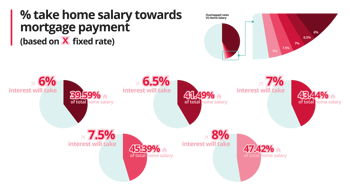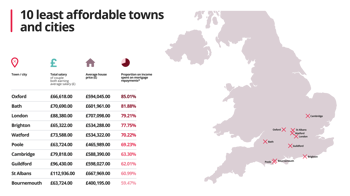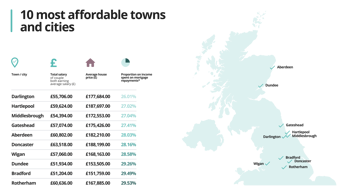Interest Rates Are Through The Roof – But Where In The UK Are Homeowners Being Squeezed The Most?
Just a few years ago, interest rates of above 5% would have been unimaginable to many people. As recently as December 2021, the average two-year fixed deal was just 2.34%. Now rates have jumped to 5.25% – the highest they’ve been since February 2008 – causing alarm for millions of homeowners coming to the end of their fixed rate deals.
In July, the BBC reported that the average rate on a two-year fixed mortgage had reached 6.7% – a 15-year high that would push up payments by at least £500 for more than a million households. However, there are frequent news stories of concerned homeowners expecting to see their monthly repayments jump by well over £1,000.

Few people can easily absorb costs like these, especially when they come on top of rising energy and food bills. While pay has increased at record levels, this is fuelling inflation concerns and the prospect of more interest hikes to come.
All this means that many households will be facing tough choices this winter. Some are cutting back on luxuries, some on essentials. They may be taking in lodgers, downsizing or moving in with relatives. The challenges are reflected in the number of home repossessions recorded this year. In the first quarter, mortgage possession claims jumped by two-fifths compared to the same period last year, and then by 15% in the second quarter.
Whilst high mortgage costs do not appear to be putting off first-time buyers, according to Halifax, some are opting for more modest homes in cheaper locations.
Budgets under strain
Of course, how much more people can expect to be squeezed depends on the outstanding balance on their mortgage, their income and other costs.
Because house prices across the UK vary so much – with the most expensive homes concentrated around London and the South-East – homeowners in some parts of the country could be disproportionately impacted by the higher costs of borrowing. The question is whether the better salaries workers can normally command in these regions are enough.
Unsurprisingly, our research reflected the famous North-South divide in the housing market.
At the time of writing (August 2023), the average rate for a two-year fixed deal is hovering just under 7% – so a couple with a combined average salary could expect as much as 43% of it to go on mortgage costs alone. This is based on them earning a combined pre-tax income of just under £63,000, and the average house price currently standing at almost £297,000.
Mortgage Rates VS Home Salary

But, as our research below reveals, households in some of the most expensive parts of the UK – where house prices can be more than double the national average – are being squeezed to impossible levels.
10 least affordable towns and cities

The university city of Oxford may be one of the most sought-after in the UK – but it comes with a hefty price-tag in the current market.
With average house prices standing at just under £600,000, and the average combined salary for a couple only marginally above the UK average at £66,618, homeowners in the city could be spending a crippling 85% of their income on their mortgage if they’re due to remortgage soon.
Just a half-a-percentage rise in mortgage rates would push this figure up to almost 89% while a ‘worst-case scenario’ of 8% would make it nearly 93%.
Other desirable locations, like Bath, Brighton, and London and the surrounding area, will also cost couples a large part of their income, according to our analysis.
With a 7% fixed-rate deal, couples in Oxford would need to earn eight times their salary to afford their current home, while those in Bath and London would have to earn 7.66 and 7.2 respectively. Given that lenders normally apply a 4.5 income multiplier, buyers in the most expensive locations may struggle to remortgage.
10 most affordable towns and cities

As expected, the most affordable places in the UK are all in the North of the UK – particularly the North-East.
Even with a 7% mortgage product, homeowners would typically spend less than 30% of their income on housing, and it drops to just over a quarter in Darlington.
Property prices in the top three locations in this list are significantly lower than the national average – £153,505 in Darlington, £151,759 in Hartlepool, and £167,885 in Middlesbrough.
However, all three of the County Durham towns suffer from higher levels of deprivation, home repossessions in the county were also among the highest in the UK in the second quarter of this year, at more than 24 per 100,000 households.
Braced for anything
After a turbulent few years, anyone working in the property industry knows to expect the unexpected. There are promising signs that inflation has finally peaked, and while interest rates could rise to 5.75% by Spring next year, the competitive nature of the mortgage market means that lenders are already starting to drop their rates.
Mike Connelly, director of Legal Bricks, an Access Legal company, said:
“As we saw in our recent conveyancing trends report, residential property transactions dropped by 23% in 2022 compared to the previous year when the Stamp Duty Land Tax (SDLT) holiday was in place.
“The past year saw relative normality return to the property market but we can’t second guess what will happen next. This is why conveyancers need to prepare for every eventuality – whether it be first-time buyers choosing a cheaper location, homeowners downsizing or even people taking advantage of lower house prices to secure a bigger property.
“Working efficiently is key to maximising these opportunities, and evidence suggests that conveyancers still struggle when volumes grow. Nationally, the average time for AP1 submissions has only dropped by 0.3 over the past year, although there are noticeable differences across the regions. In the North-East, the time has dropped by two days but submission times in London and the South-East actually went up, possibly because of volume pressures.
“As we saw with the SDLT, easy to use and cloud based conveyancing software will help teams to work more efficiently and profitably when there is an influx of business. By using conveyancing technology to reduce the most labour-intensive processes, conveyancing teams within law firms can ensure they maximise the value of each case to compensate for a potentially lighter workload – and then be ready to move quickly when the market picks up again.”
Methodology
*The data is based on a list of the UK’s 100 biggest cities and towns. Rightmove data has been used to establish the average house price for each location (as of July 2023)
A mortgage interest calculator was used to work out estimated monthly payments based on a range of different interest rate payments, above and beyond the current average interest rate.
To provide a comparison to salary data for each area, the latest available data from the ONS was evaluated. This is based on all workers (disregarding the gender split, PT v FT workers etc.).
Based on the above figures, the take home salary for each location was calculated using The Salary Calculator. As a guide this was then doubled to provide an approximate average take home salary per month for a couple and determine the percentage of monthly take home per couple in each location based on each of the various interest rates.


